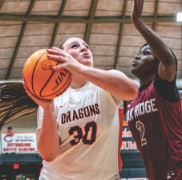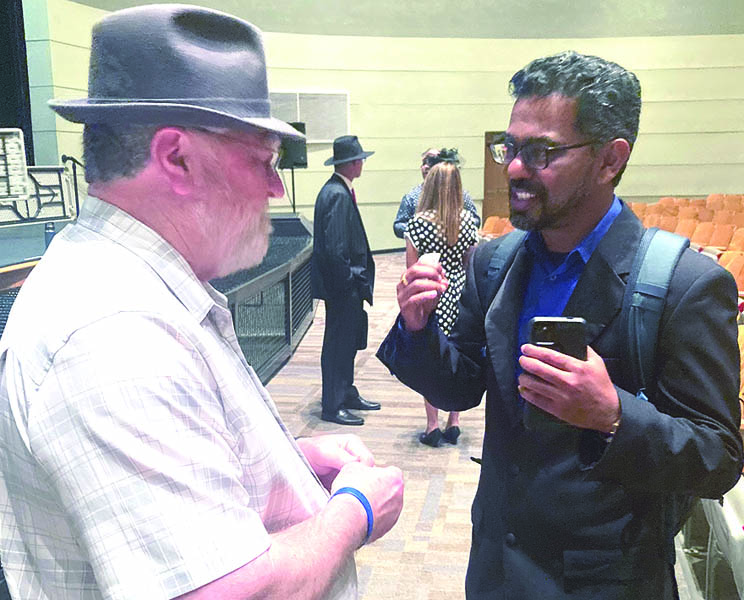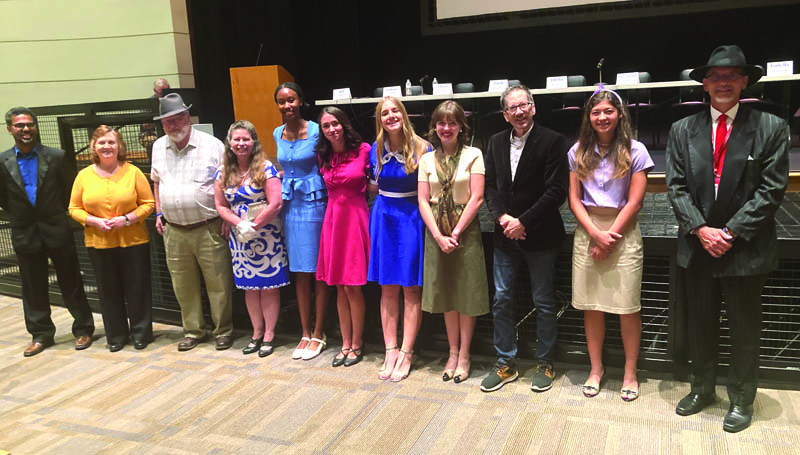Students and experts discuss Oppenheimer and AI
With rapid advancements in artificial intelligence and the movie “Oppenheimer” in theaters, some are wondering what lessons we can learn from the past as we head toward the future.
Experts from ORNL, DOE and UT, a local historian, and some Oak Ridge High School students held a panel discussion before a showing of the documentary “Oppenheimer After Trinity” at Oak Ridge High School Wednesday, July 19.
The panelists included Lynne Parker, director of the AI Tennessee Initiative at University of Tennessee Knoxville; Prasanna Balaprakash, director of the ORNL Artificial Intelligence Initiative; Julie Ezold, technical advisor for the Department of Energy Isotope Program; Trent Di Giulio, director of “Oppenheimer After Trinity”; and D. Ray Smith, Oak Ridge historian. Oak Ridge High School students Aaliyah Herron, Dakota Forelle, Isabella Zolnierczuk, Odelia Kneiser and Elena Vogt also spoke.
The documentary “Oppenheimer After Trinity,” like the recent fictionalized film “Oppenheimer” tells the story of physicist Julius Robert Oppenheimer. It includes his work on nuclear weapons tests in New Mexico during World War II, his tense meeting with Harry S. Truman, difficulties during the Cold War and retirement on St. John Island. The documentary and the fictionalized movie do not focus on Oak Ridge, a city which Oppenheimer visited. However, Smith filled in the details of how Oppenheimer affected Oak Ridge.
As Smith explained, Major General Leslie Groves oversaw the Manhattan Project which involved research and construction on nuclear weapons in multiple places. He hired Oppenheimer and chose the location of Oak Ridge for Uranium enrichment. Frank Oppenheimer, Robert’s brother lived in Oak Ridge for a year from 1943 through 1944. Frank worked at Y-12, at that time an electromagnetic separation plant. Robert visited his brother during that time.
Smith said that Robert Oppenheimer was “very influential” in continuing the work to separate uranium-235, rather than turning the focus toward plutonium. He also requested the building of a thermal diffusion plant near the K-25 site called S-50 which sped up the enrichment process for Little Boy, the bomb dropped on Hiroshima, Japan. Smith said Robert Oppenheimer sent Richard Feynman to advise people in Oak Ridge on uranium safety. One photograph shows Robert Oppenheimer at Oak Ridge’s Alexander Guest House, which is now a senior living center. The building still includes the fireplace shown in that photo.
“The people at that senior living center are just delighted to have that connection to Robert Oppenheimer and the Manhattan Project,” Smith said. “Robert Oppenheimer had a lot to do with what we did in Oak Ridge to produce the uranium for Little Boy.”
But the rest of the panel discussion focused less on Oppenheimer or on nuclear technology and more on artificial intelligence. Di Giulio said he’d used artificial intelligence to edit his film and that advancements with technology are moving “faster and faster now.” Panelists said AI faces parallel questions to nuclear technology, specifically in terms of how people should regulate it.
“The potential benefits of AI are countless, but so are the risks,” Vogt told the audience. “AI has become the new atomic bomb.” While people weren’t allowed to ask questions with the development of nuclear weapons, Vogt said they can with the development of AI.
Ezold explained at the meeting Oak Ridge is leading the way in AI just like it led the way for nuclear technology. She said ORNL’s Frontier supercomputer was ranked number one in performing artificial intelligence functions. She said collaborators with the lab from different institutions have access to it for “solving fundamental science questions.”
Balaprakash summed up the various technologies called AI.
“It’s a collection of technologies where we are trying to automate various kinds of tasks that we humans do,” he said but added that it is aiming to be “much, much faster” than how a human might do them.
“Easy problems are hard. Hard problems are easy,” he said. For instance, equations for sending a rocket to Mars are easier for artificial intelligence than finding a cat in a picture. The first revolves around rules whereas the second revolves more around recognizing examples and making predictions.
Parker spoke of risks, benefits and regulation. She said people, especially governments, can use AI to spread inaccurate information, crush political dissent and do surveillance on large groups of people. However, she said people can get so frightened that they do not take the beneficial uses of artificial intelligence, such as helping with access to housing, into account.
“If you look at the media today, a lot of the publication and a lot of the conversation around AI is scared,” she said. However, she said she regulations should focus on maximizing benefit as well as minimizing harm. Several student speakers spoke about the benefits or harm AI had for their respective fields.
Herron spoke of AI in Classical music. Kneiser talked about the potential ability for AI to study landscapes for conservation but also said the AI’s themselves lead to carbon emissions. Zolnieczuk had many thoughts on AI in her desired future career field of medicine.
“I think AI should be used solely as a tool,” she said, rather than replacing surgeons and physicians entirely. She also was against people using AI’s to replace human companions for psychological help.
“It absolutely cannot replace a friend,” she said.
“Our only savior from innovation is innovation,” Vogt said at the end of the panel discussion. “Keep talking. Keep learning. Keep innovating.”



